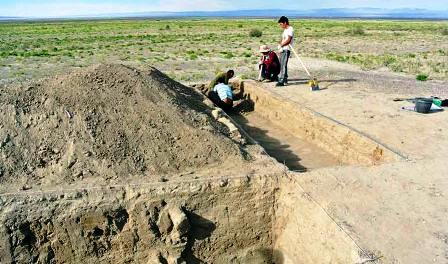Archeologists Uncover Genghis Khan’s Lost Mongolian Fortress
March 4, 2015 | by Lisa Winter

Genghis Khan, born as Temujin in 1162, became one of the greatest military leaders of all time by building and ruling the Mongol Empire. At the time of his death, he ruled from the eastern stretches of Asia to as far west as Russia. A team of Mongolian and Japanese researchers uncovered a fortress that has now been confirmed to have been used by the ruler during the 13th century. This discovery could help historians better understand how the growth of the empire expanded westward toward Europe.
Genghis Khan (also known as Chengis Khan), which translates into Supreme Leader, once controlled over 12 million square miles across Asia. The Mongol Empire was second only to the British Empire in terms of expanse. While tribes were given the opportunity to surrender peacefully, resistance was met with great force. It is believed that during his life, Genghis Khan was responsible for the deaths of over 40 million people. However, some historians debate the validity of the extent of Genghis Khan’s carnage, attributing much of it to hearsay meant to strike fear into his enemies.

Koichi Matsuda from Osaka International University led the team that uncovered the fortress in 2001 in southwestern Mongolia. The landscape near the site aligned with a description of the fortress by a Tao spiritual leader in a book from around the same period. It is located about 880 kilometers (547 miles) west of Mongolia’s capital city, Ulan Bator.
Artifacts from the site included animal bones, Chinese pottery, and wood fragments. Carbon dating of the items revealed that they ranged from the 12th through 14th centuries. The fortress, which measures 170 meters by 200 meters (557 by 655 feet), had walls made out of soil. It is believed that the fortress was constructed in 1212, and was most likely commissioned by one of Genghis Khan’s top officials.
Matsuda told Nihon Keizai Shinbun, a Japanese newspaper, that the fortress was a powerful garrison during its day. The location of the fortress, named Chinkai Castle, was positioned near farmland and also along silk trade routes that would have been useful as the Mongolian army forged west. This would have given it plentiful access to necessary provisions, as well as access to information carried by travelers.
After the decline of the Mongol Empire, Chinkai Castle dwindled into ruins during the 14th century, and eventually became lost to history. Its rediscovery and confirmation of identity is an important part of Asian history, and it could have a great deal to teach historians about the westward expansion of Genghis Khan’s army
Bron:
Bron:

Geen opmerkingen:
Een reactie posten